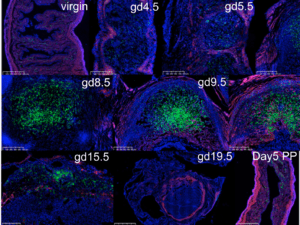
Time course of GFP+ cells accumulating in Ncr1iCre 3 RosamT/mG dams during pregnancy. (A) The uteri of pregnant Ncr1iCre X RosamT/mG reporter mice were prepared for histology at the indicated gestational day (gd). Green dots represent GFP+ NK cells (Source: Sojka et al., 2018)
Natural killer (NK) cells are innate cells that provide early protection against infection and tumors. These cells can be grouped into circulating (blood) conventional NK (cNK) or tissue resident NK (trNK) cells, which can be distinguished based on exclusive expression of DX5 (cNKs) and CD49a (trNKs), respectively. In the uterus trNK cells known as uterine NK (uNK) cells constitute 70% of total lymphocytes during early stages of gestation. Whether uNK cells originate from cNK or trNK cells is still contentious.
Sojka et al., used a novel NK cell reporter mouse model to determine which cell population cNK or trNK cells is responsible for proliferation of uNK cells during pregnancy. Using this mouse model researchers were able to detect uNK cells based on expression of the fluorescent protein, GFP. Interestingly, these GFP+ uNK cells consisted of both cNK and trNK cell populations. During pregnancy they observed accumulation uNKs cells using on BrdU incorporation and Ki67 expression, were predominantly proliferating trNK cells. To determine if accumulation of trNK cells is due proliferation of trNK cells or migration of cNKs to the uterus, they performed parabiosis* experiments. Unfortunately, the parabiosis experiment inhibited successful pregnancy. Thus, researchers experimentally induced decidualization# to mimic early stages of natural pregnancy. Experimental of decidualization also resulted in the same uNK cell kinetics observed in natural pregnancy. Thus, using parabiosis surgery during artificial decidualization, researchers showed that accumulation of uNK cells is exclusively due to local proliferation of CD49a+ trNK cells and not due to migration of cNK cells to the uterus.
In summary, Sojka et al., showed that though trNK cells as well as cNK cells are observed in the uterus. However, the primary responding NK cells that accumulates during pregnancy are proliferating tissue resident NK cells and not recently migrated conventional NK cells.
Notes: *Parabiosis experiment is a surgical union of two organisms allowing sharing of the blood circulation. #Decidualization is the transformation of the endometrium in preparation for, and during pregnancy to provide a nutritive and immunoprivileged matrix essential for embryo implantation and placental development
Journal Article: Sojka et al., 2018. Local Proliferation of Uterine Tissue-Resident NK Cells during Decidualization in Mice. Journal of Immunology
Article by Cheleka AM Mpande










